In the hot summer weather, our consumption of fruits also increases. In the summer, many types of fruits can help cool down, hydrate, and relieve the fatigue of the summer sun, such as pineapple, mango, watermelon, citrus fruits, etc. Among them, we cannot forget about watermelon – a refreshing fruit in the summer.
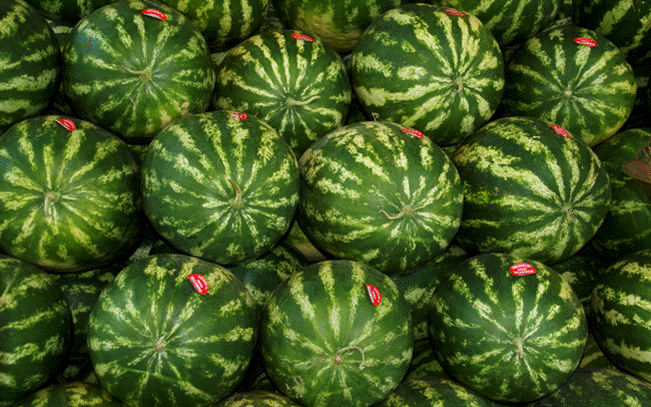
Eating watermelon in the summer has many health benefits.
What are the benefits of eating watermelon in the summer?
According to Healthline, watermelon has long been considered a rich source of nutrients. It contains lycopene, vitamin A, citrulline, and vitamin C. These nutrients all have positive effects on your health.
1. Improves skin health
If you have struggled with dark spots on your skin for a long time. Or if you want a brighter complexion, try eating a slice of watermelon every day. According to experts, the vitamin A in watermelon helps promote the development of tissues in your body, thereby rejuvenating your skin.
2. Boosts cardiovascular health
The lycopene in watermelon can improve heart function. Moreover, vitamin C, carotenoids, and potassium help reduce cholesterol and keep your heart safe from any dangerous situations.
Although there are benefits in this aspect, watermelon should not be regarded as a life-saving medicine, and those who are experiencing chest pain or serious heart problems should seek immediate medical attention.
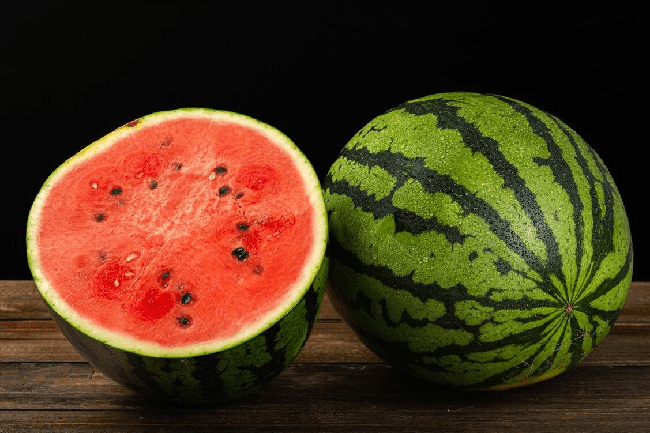
Watermelon contains many antioxidants and vitamins that are good for health, especially its ability to rejuvenate the skin.
3. Improves kidney function
Keeping the kidneys healthy is extremely important if you don’t want to suffer from kidney diseases. It cannot be said that watermelon can completely prevent kidney stones, but it will not add stress to your kidneys, increase urine flow, remove excess fluid from your body, and reduce the risk of kidney stones.
4. Improves vision
Adding a slice of watermelon to your daily diet can also benefit your eyesight and overall eye health. This is also due to its vitamin A content, a nutrient that can help protect the eyes from age-related macular degeneration and cataracts.
5. Helps strengthen bones
As we age, our bones tend to weaken, and only by maintaining strong bones can we move comfortably. Luckily, watermelon contains lycopene and potassium, which can help make your joints healthier, reduce the risk of injuries or bone degeneration.
6. Helps stabilize blood pressure
Many people try to lower their blood pressure through diet and exercise, and watermelon should definitely be included in that meal plan. Because watermelon contains a lot of potassium and magnesium, it is very beneficial for stabilizing blood pressure.
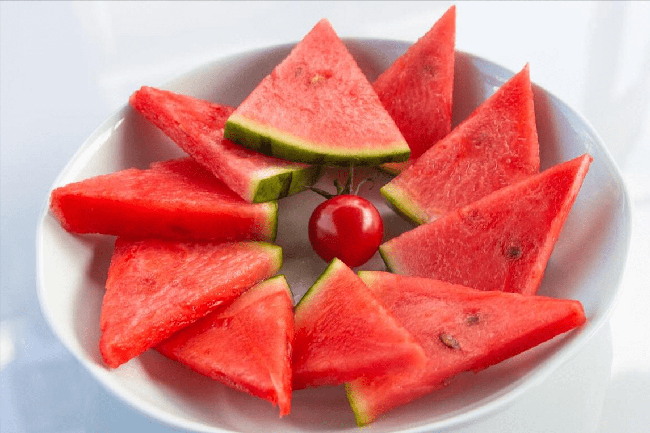
Watermelon is a fruit with great anti-inflammatory properties.
7. Reduces muscle soreness
Watermelon is also great for reducing inflammation and relieving muscle soreness. A study found that people who drank watermelon juice before exercising experienced less muscle soreness 24 hours after exercise. However, because watermelon juice contains a lot of fructose, it is not recommended to drink the juice, eating the fruit would be better.
How to choose watermelon with thin skin and juicy flesh
The method of tapping on the watermelon to listen for a “hollow, dull” sound may not be accurate when you want to choose a sweet and delicious watermelon. Many people tap on the watermelon to listen for a hollow sound, thinking that the fruit will be sweet and ripe.
But not everyone can distinguish what is a hollow sound and what is a dull sound. Sometimes when buying watermelons at the market or from street vendors, you might not have the strength to tap on all the watermelons. So let’s look at these three points, they will help you buy watermelons with thin skin, sweet, and juicy flesh.
1. Look at the color
Speaking of color, it’s not about looking at the overall color of the watermelon, but mainly looking at the yellow spot on the watermelon. This yellow spot indicates that the watermelon is fully ripe. This is the part that touches the ground, the larger it is, the riper the watermelon. When buying watermelon, you should choose the part with a yellow spot, it will be better.
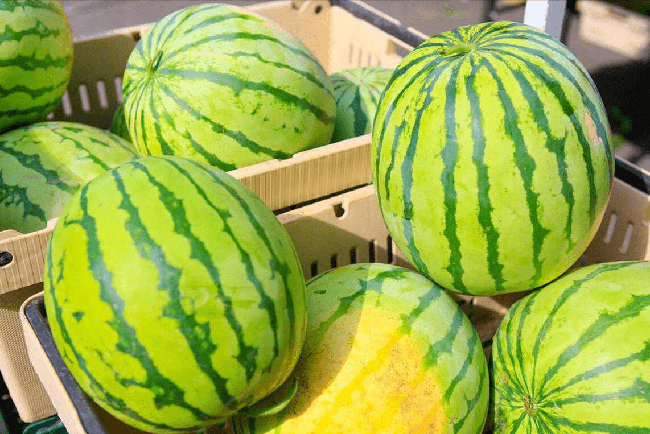
Watermelons with a yellow spot are usually sweeter and have thinner skin.
2. Look at the belly button of the watermelon
Look at the belly button of the watermelon, this part also has different sizes, some are big, some are small. When choosing, you should choose a watermelon with a smaller belly button. A smaller belly button means a thinner skin and a sweeter rind.
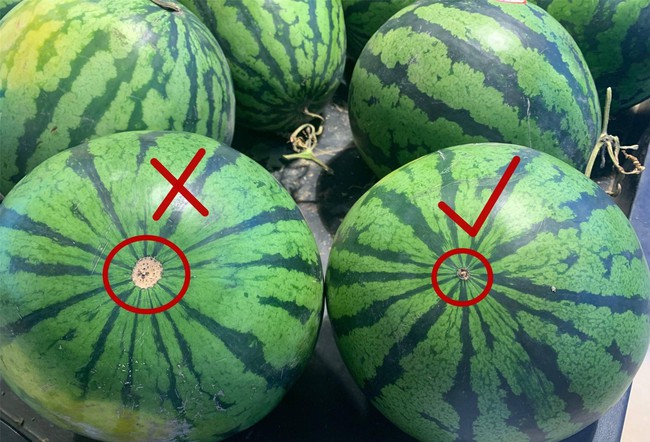
Choose watermelons with a smaller belly button that is concave, they will be sweeter and have thinner skin.
3. Look at the stripes
The stripes on the top of the watermelon are also a point to distinguish whether the watermelon is good or not, we need to choose watermelons with clear stripes, darker colors, and even distribution, as these characteristics indicate that the watermelon is sweeter and more delicious.

Choose watermelons with clear stripes (on the right) instead of watermelons with messy stripes (on the left).
The color of the stripes on the watermelon peel is relatively pale, the stripes are unruly, this type of watermelon is not delicious, it may not be fully ripe.
4. Look at the watermelon stem
If the watermelon still has a stem, observe it carefully. If the stem is withered, it indicates that the watermelon is ripe, perfectly ripe. If the stem is still green and plump, pay attention as it may not be fully ripe. Another tip you can consider is to choose a watermelon that is slightly curved, it will be tastier than a straight watermelon.
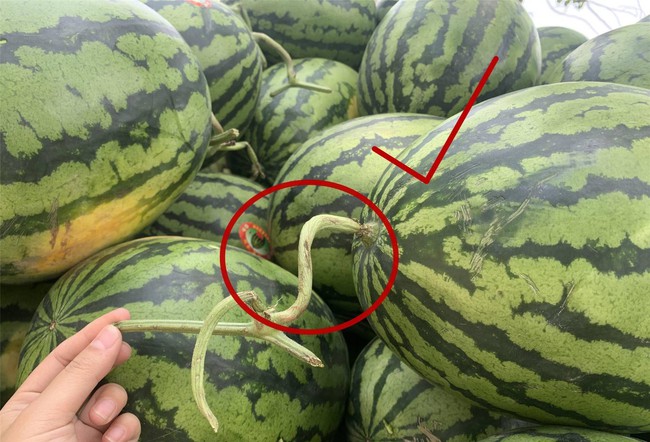
Look at the watermelon stem to gather more data to help you choose a good watermelon.
How to eat watermelon the best way?
Compared to cooking, watermelon is more suitable for eating directly. You can make juice, smoothies, or salads out of it. However, when eating watermelon, you should also keep in mind a few important things.
– The summer is prone to food poisoning and diarrhea, so it’s best to choose the freshest watermelon possible, this type of watermelon has high water content, is refreshing, has no strange smell, and can ensure its detoxifying and nutritional properties without being destroyed. But remember, don’t eat too much.
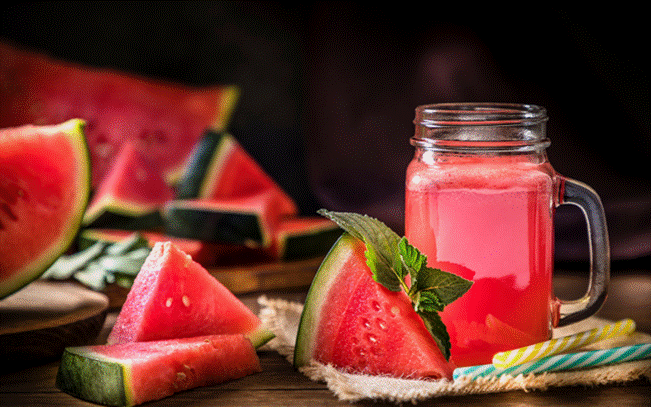
In addition to eating it directly, you can make watermelon juice or smoothies, watermelon salad.
– Do not eat watermelon that has been cut for too long. In the summer, the temperature is relatively high, and watermelon will spoil easily after it has been cut, because of its relatively high sugar content, it’s very prone to bacterial growth. At this time, it is not suitable for consumption.
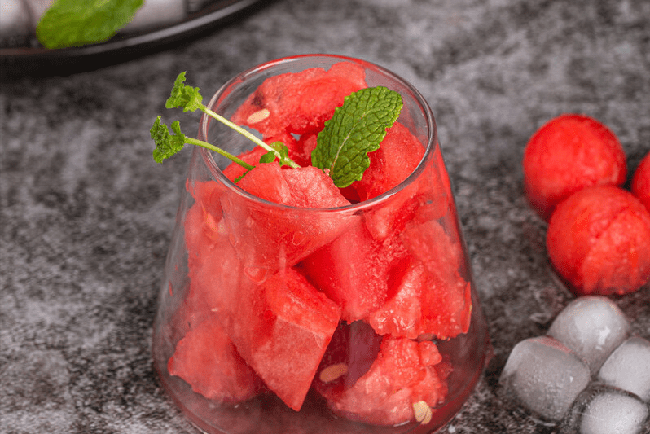
Even though watermelon is cooling and refreshing, you should not eat too much as it may cause indigestion.
– Do not refrigerate watermelon for too long. Although having a refreshing piece of watermelon in the fridge on a sunny day will instantly make you feel refreshed. However, this will harm your stomach. Your body is hot, and suddenly eating cold watermelon will stimulate your stomach and can easily cause stomach pain. When eating watermelon, it should be at room temperature, just cool enough, do not refrigerate it.
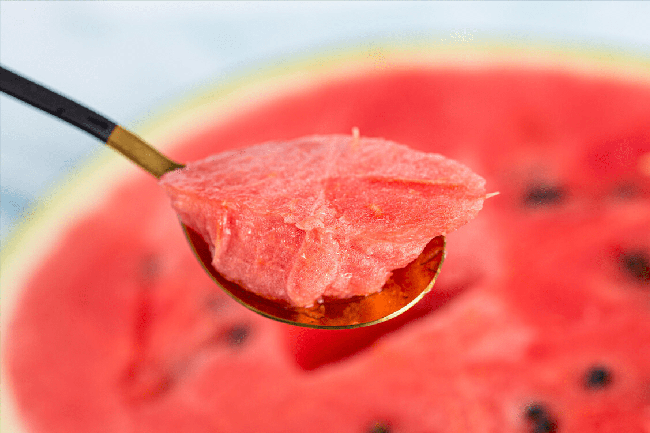
Do not leave the watermelon outside in the air for too long.
– Do not eat watermelon that has been wrapped in food wrap for too long. As mentioned earlier, after watermelon has been cut, it will be exposed to a lot of air, combined with its high sugar content, it will cause bacteria to grow quickly. This is also the case when it is used with food wrap or left in the air for too long. Eating watermelon in this way is very likely to cause stomach ache.
According to PNVN


































